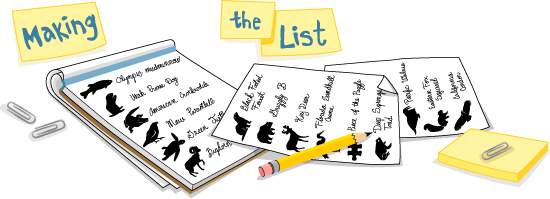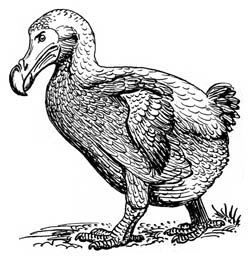
Illustrated by: Sabine Deviche
Endangered Species List
The St. Lucia forest thrush is small bird that lives on the island of St. Lucia in the West Indies. On August 17, 2010, this Caribbean bird got some good news and some bad news. The good news was that it had made the list of species protected by the US Endangered Species Act. The bad news; making the list meant the thrush was in danger of becoming extinct.

Have you ever heard someone say, “they went the way of the dodo?” It's an expression that means to become extinct. Dodos were a bird hunted to extinction over 300 years ago. Like the dodo, passenger pigeons also once existed in huge numbers. There used to be so many passenger pigeons that when a flock flew over, the sky would turn dark. But passenger pigeons went the way of the dodo. The last passenger pigeon, a female named Martha, died in a zoo in 1914.
But, neither the dodo nor the passenger pigeon can be considered the first endangered species in the US. Even though they went extinct like thousands of other plants and animals have gone extinct, they were never part of a formal list of endangered species like the forest thrush. It was not until 1964 that the first US list was created to track the status of endangered plants and animals.

On the Species List
By the time the first endangered species list was made, many species had already gone extinct. Some species, like whooping cranes, were almost extinct at that time. But the US government did not begin to protect animals as endangered species until they were put on the official endangered species list. The first US list contained 62 different species: 15 mammals, 36 birds, 3 reptiles, 2 amphibians, and 6 fish.
Who Made the First Endangered Species List?
In 1964, the US government created a nine-person panel to make the first endangered species list. The panel members were biologists and wildlife managers that worked for the government. The group was called the Committee on Rare and Endangered Wildlife Species, or CREWS for short. CREWS made a book that had one page for each of the first 62 endangered species. Each page gave some information about the species and why it was endangered. The book was named the Red Book, since red is a color of danger or warning. If a species of animal had a page in the Red Book people would know it was in danger of becoming extinct.
Seeing Red
The US is not the only country to make a red list of endangered species. A simple Web search will turn up a number of other red lists from different countries. The most famous of these is the IUCN (International Union for the Conservation of Nature) Red List of Threatened Species. The IUCN Red List contains a page for every species in the world considered to be endangered. The first IUCN list was made about the same time as the US Red Book and is still maintained today.
What used to be called the US Red Book can now be found on the US Fish and Wildlife Service website. The new red book is called the Threatened and Endangered Species System or TESS.
Additional images via Wikimedia Commons. Forest thrush by Jean-Michel Fenerole.
Read more about: Making the List
Bibliographic details:
- Article: Making the List
- Author(s): Johnny Winston
- Publisher: Arizona State University School of Life Sciences Ask A Biologist
- Site name: ASU - Ask A Biologist
- Date published: 28 Jan, 2011
- Date accessed:
- Link: https://askabiologist.asu.edu/explore/making-list
APA Style
Johnny Winston. (Fri, 01/28/2011 - 11:06). Making the List. ASU - Ask A Biologist. Retrieved from https://askabiologist.asu.edu/explore/making-list
Chicago Manual of Style
Johnny Winston. "Making the List". ASU - Ask A Biologist. 28 Jan 2011. https://askabiologist.asu.edu/explore/making-list
Johnny Winston. "Making the List". ASU - Ask A Biologist. 28 Jan 2011. ASU - Ask A Biologist, Web. https://askabiologist.asu.edu/explore/making-list
MLA 2017 Style

This small Caribbean bird, the forest thrush, got some good news and some bad news.
Be Part of
Ask A Biologist
By volunteering, or simply sending us feedback on the site. Scientists, teachers, writers, illustrators, and translators are all important to the program. If you are interested in helping with the website we have a Volunteers page to get the process started.




